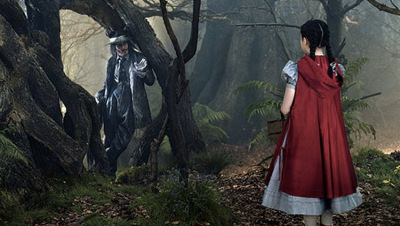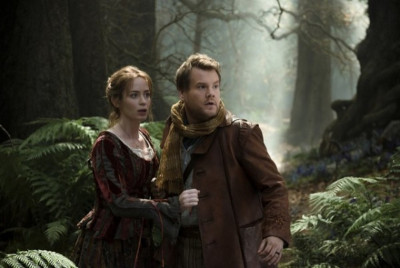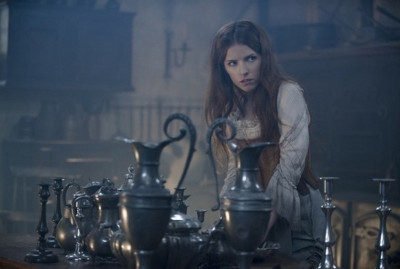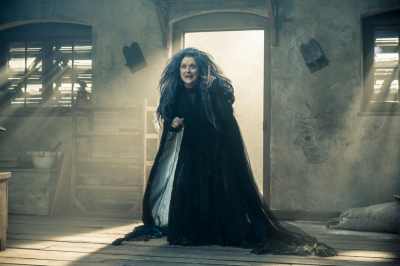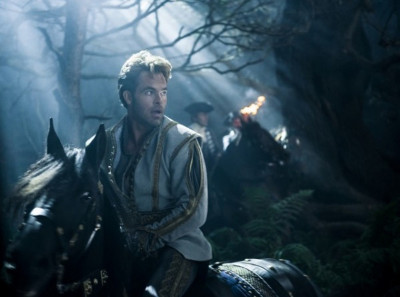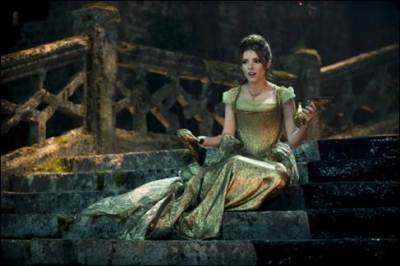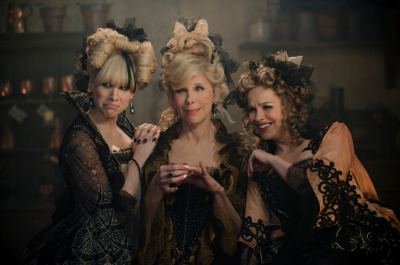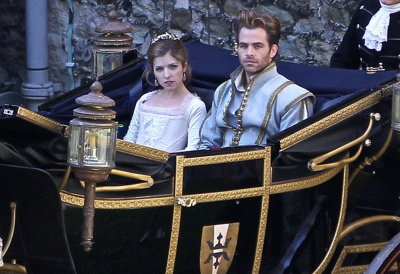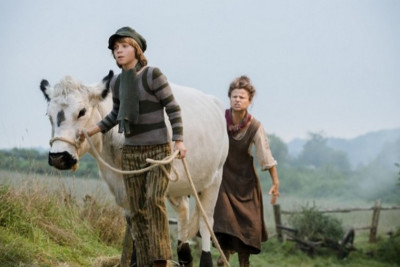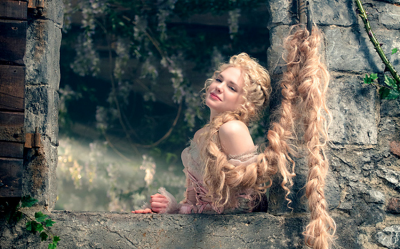Fans of the stage musical, and those who have heard of but never seen the wonder that is Stephen Sondheim, are in for a special holiday treat come Christmas Day as all tied up with a big red bow, er, cape, is Sondheim’s acclaimed and long-running INTO THE WOODS which finally arrives on the big screen in this stunning adaptation written by stage scribe James Lapine and Stephen Sondheim and directed by Rob Marshall. What big eyes you’ll have as you watch the magic of this fairytale mash-up unfold in all its visual and musical splendor.
For those unfamiliar with this now classic Broadway telling, INTO THE WOODS is the melding of the best of the Grimm Brothers fairytales and characters, just tweaked a little, as the individual tales overlap and come together, and all with more than a bit of a darker twist celebratory of the original fairytales as opposed to the centuries of sanitized “happily ever afters”.
From the film’s opening, music knows no bounds and thanks to the introductory “Into the Woods”, we meet all of our characters and learn their desires and desired. The Baker and Mrs. Baker want nothing more than to have a child, but have been unable to thanks to a curse that the Witch who lives next door placed on Baker’s father when he snuck into her garden to steal not just her precious greens, but all the witch’s magic beans. But the Witch is willing to make a deal and reverse the curse if Baker will go into the woods and, before the chime of midnight in three day’s time, bring to her the cow as white as milk, the cape as red as blood, the hair as yellow as corn, the slipper as pure gold. Of course, all of these are iconic items significant to the stories of other folks in fairytale kingdom.
And while the Witch is weaving her spell on Baker and Mrs. Baker, the musical montage also introduces us to Little Red Riding Hood who is heading into the woods to see her Grandmother; Jack, who has been ordered by his mother to take his beloved cow Milky-White to market in exchange for money for food; Rapunzel, who has been hidden away in a tower imprisoned by her “mother”, the Witch; and Cinderella, who wants to go to the festival and dance before the Prince.
As is trademark Sondheim, the journey INTO THE WOODS is metaphoric for the journeys and paths we each must travel in life while providing an intricate commentary on society and the world. Introducing complex themes that center around the ideologies of love, loss, greed, and the seven deadly sins, life changing events face each of our characters as Cinderella finds her backbone to defy her Stepmother, but at what cost, and is the grass really greener on the other side; Jack, who doesn’t listen to his mother and swaps Milky-White with the Baker for some magic beans, takes the easy way out and dreams big reaching for the pie, or golden harp, in the sky; Red Riding Hood faces her own awakening thanks to a dastardly seductive Wolf; as for Prince Charming, well he might not be all that charming once you look behind his over-inflated ego; and then the poor Bakers – they keep losing the very things they find and keep running in circles in pursuit of their dream.
But what happens when all the fairytale worlds collide and each must face the consequences of their actions?
Adapted by James Lapine who wrote the book for the stage musical, and Stephen Sondheim who adapts some of his songs for the film while keeping the majority true to their original form, INTO THE WOODS is laced with innuendo (particularly in the encounter between a zoot-suited whisker twirling Wolf played by Johnny Depp and Little Red Riding Hood) but above all, as we are seeing with the recent crop of Disney releases like “Maleficent”, doesn’t sugarcoat either the fairytale world on screen or its real world counterpart. Focusing on the psychological aspects and morality laced symbolism of the woods, lyrics speak volumes about life, our pursuits, our compromises, our “settling of mediocrity”, our curiosity, e.g., “Isn’t it nice to know a lot? And a little bit not.” or “Is it always ‘or’? Is it never ‘and’?” A testament to the skill of Sondheim and Lapine is that the story and songs are accessible to multiple generations, speaking to each with the same words, but with different meaning and interpretation given a person’s age and life experience. Notable is that according to Rob Marshall, “[Lapine and Sondheim] were so flexible about the material, even more flexible in a weird way than I was. . .They understood this was a film and there are certain things you can’t do. The stage conventions of speaking directly to an audience or singing directly to an audience you can’t do on film. It doesn’t work. So you have to reimagine those kind of things and that’s what we did throughout.”
Story structure is well defined with the first half of the film setting the stage for “happily ever after” and were this 1939 or Broadway, after a brief intermezzo, the second half addressing the consequences of the perceived happiness. Tonal shift is beautifully executed not only due to Lapine’s script, but the work of cinematographer Dion Beebe and editor Wyatt Smith who seamlessly transition lighting and lensing, sometimes even within a specific song sequence, complete with fast camera movement and fast cuts. Beebe makes great use of a two or wide shot to open up the frame while allowing our gaze to focus not only on the performances, but on the peripheral intricacies of the production design. Adding great texture and depth of field to the proceedings is the use of midnight blues and its variant hues in the color wash of the woods. As opposed to the oft over-used brown and greys, here, production designer Dennis Gassner and Beebe combine their visual talents to deliver a beauteous pallette with a more fairytale feel.
One of Rob Marshall’s strong suits in his direction of INTO THE WOODS is his decision to use practical sets, and in the case of Jack’s Giant (wonderfully played by “Harry Potter” veteran Frances de la Tour), miniatures. Steeping the actors in the physical moment, especially with something that has to have the flow, the lyrical flow and melodic flow that compliments the music, adds texture and emotional resonance to the performances and the film as a whole. As Marshall told me, “Even though it is a fairy tale and we live in a heightened reality in this movie, I wanted it to feel real. I wanted the people to be ‘real’ because you’re asked to care for them, you’re asked to really follow their journeys. So when it gets to the end of the piece, you’re really asked to be with them and feel for them. . .I like to give the actors the best chance to do that and for me, it’s being in a real space, not like in a green room somewhere trying to pretend they’re doing something. I feel like if they can be in a real woods – Granny’s tree, for instance, is a real tree. And Windsor Great Park or the tree that Jack is climbing in ‘Giants in the Sky’ is a real tree, a real castle. We went to Dover Castle. Somehow I just feel that it brings it all to life in a much more true way because it’s tangible.” Among the locations selected for filming are Ashridge Estate outside Berkhamsted, England. An ancient forest, Ashridge became home to Jack and Milky-White complete with the beanstalk tree and a turn-of-the-century barn, while the Baker’s village was Hambleden Village. Breathtaking are the Cascade Waterfalls which serve as the backdrop to the single most outstanding and hilarious scene of the film – “Agony” performed by Handsome Prince Charming Chris Pine and Other-Handsome Prince Billy Magnussen. No stone of reality was left unturned.
The authenticity of the locations and practical sets also afford Marshall the ability to create an emotional intimacy (especially in the woods themselves) that has an expansive, non-claustrophobic feel. However, while I find the film more restrained or tempered than I had hoped it would be given the visual possibilities of adapting for film, and all the tools available to Marshall in the cinematic toolbox, Marshall addressed my concerns, supporting the more theatrical staging as opposed to over-the-top effects. “The most important thing is to serve the actor for me, and serve the piece, and serve the story. So I only use the tools that you’re describing when that enhances that. . .[I]t should feel like it’s unfolding naturally, organically flowing, fluidly. Same with the editing, same with all of it. It should look like it’s all happening and we’re just involved in that. . .I want you to go into this piece and feel like you’re inside it and it’s happening organically.” Significant too, is that the real magic of INTO THE WOODS is Sondheim’s music which never requires effects to make it soar. (And with the orchestrations here being the originals by Jonathan Tunick and conducted by Paul Gemignani, it’s as if the heavens have opened.)
But with an adaptation of a Stephen Sondheim musical comes the need for actors who can act and sing. A virtually flawless casting of talent, performance surprises abound, most notably Chris Pine who steals the entire film not only with his egomaniacal self-deprecating comedic delivery and perfect timing as Prince Charming, but with his showstopping performance of “Agony”! (Is it Chris Pine or is this William Shatner? The performance stylings of the two Star Trek captains is becoming eerily similar – and welcome!)
Another surprise is Emily Blunt. We know she can act, but we didn’t know she can sing. And boy can she. But beyond the voice, it’s Blunt’s performance that is the heart and soul of INTO THE WOODS. She is the most emotionally resonant of the characters and the actors, tapping into a multiplicity of emotions dependent upon character interaction, with each as engaging and believable as the next. Where Blunt really hits the nail on the head, however, is going toe-to-toe with Meryl Streep. As we have seen time and again with Streep and Blunt, they are a force to be reckoned with and here is no different. Their emotional one-two dance is both exciting and heartwarming to watch.
And what of Meryl Streep? Proving her vocal mettle in “Mamma Mia!”, we know Streep can sing, but what of the verbal gymnastics and intricate musicality of a Sondheim song? Streep nails it. And surprisingly, while all the musical performances were pre-recorded, on each day of shooting the actors were given the option of singing live for the film. According to co-star Christine Baranski, for Streep’s opening prologue number singing about greens and the Witch’s curse, Streep “ripped out her earwig and sang live.” But it’s Streep’s riveting performance of “Children Will Listen” that will bring a tear to your eye and have you begging for more. The emotion she brings to this piece is beyond palpable.
No stranger to Sondheim or Rob Marshall is Christine Baranski who is a haughty delight as the Stepmother, giving her an almost Sharon Osborne flair. Baranski is divine both in performance and musicality. As stepdaughters Lucinda and Florinda are Lucy Punch and Tammy Blanchard, respectively, with each adding fuel to the fire of fun.
While I am ambivalent as to her casting as Cinderella, there is no doubt about Anna Kendrick’s vocal skills. Theatre trained and learning musical chops on stage early on, her musicality here is flawless. Unfortunately, I find her performance a bit uncomfortable and perhaps even miscast.
And speaking of uncomfortable, how about uncomfortable perfection, in which case look no further than Johnny Depp as the salacious Wolf. Looking every bit the part of a wolf and attired in one of costume designer Colleen Atwood’s most stunning pieces in INTO THE WOODS, Depp’s seductive performance with the young Lilla Crawford as Little Red Riding Hood may prove unsettling for some parents, although I doubt children will understand the underpinnings of Depp’s performance and the character.
Not to be overlooked are Tracey Ullman as Jack’s downtrodden, strict, yet loving Mother, Billy Magnussen as the Not-So-Charming Prince who pines for Rapunzel, an adorable Daniel Huttlestone as Jack, and of course, James Corden as The Baker. Corden is just a teddy bear whose mere presence will make anyone feel safe in the woods, even if Baker is shaking in his boots. And if you haven’t heard Corden sing in any of his other films out this year (“Begin Again” and “Once”, you are in for a real treat here.)
Of course, what would a film like INTO THE WOODS be without the costuming of Colleen Atwood. Her designs stun, particularly with the costuming of the Wolf and the Witch, the latter of which even through character transformation, has costumes made of textiles that carry the themes of the film. Beautiful fabrications. Breathtaking work by Atwood. I hear Oscar calling.
Be you a lover of the stage musical or if this is your first time going INTO THE WOODS, children – and adults – should listen. Sondheim soars. Marshall works his magic. INTO THE WOODS is truly a trip worth taking this holiday season.
Directed by Rob Marshall
Screenplay by James Lapine based on the musical by James Lapine and Stephen Sondheim. Music and Lyrics by Stephen Sondheim.
Cast: Meryl Streep, Emily Blunt, James Corden, Anna Kendrick, Chris Pine, Christine Baranski, Tracey Ullman, Daniel Huttlestone, Lilla Crawford, Tammy Blanchard, Lucy Punch, Billy Magnussen, Johnny Depp

